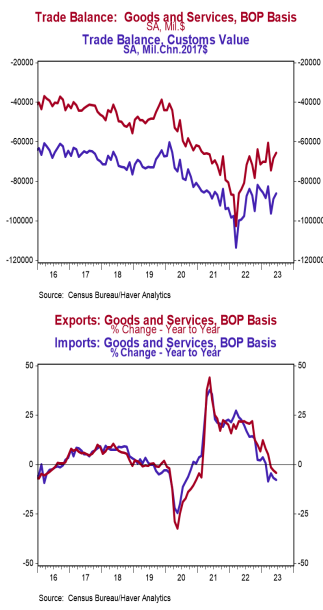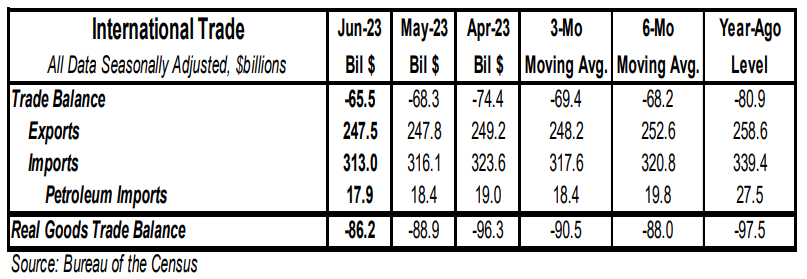- The trade deficit in goods and services came in at $65.5 billion in June, slightly larger than the consensus expected $65.0 billion.
- Exports declined by $0.3 billion, led by civilian aircraft and pharmaceuticals. Imports declined by $3.1 billion, led by finished metal shapes, computers, and crude oil.
- In the last year, exports are down 4.3% while imports are down 7.8%.
- Compared to a year ago, the monthly trade deficit is $15.4 billion smaller; after adjusting for inflation, the “real” trade deficit in goods is $11.3 billion smaller than a year ago. The “real” change is the trade indicator most important for measuring real GDP.
Implications:
The trade deficit in goods and services fell to $65.5 billion in June as both imports and exports declined. We like to focus on the total volume of trade, imports plus exports, as it shows the extent of business and consumer interactions across the US border. This measure fell by $3.5 billion in June and is down 6.3% versus a year ago. These declines are consistent with our forecast that the US is headed toward a recession. Imports declined by $3.1 billion in June and are down 7.8% versus a year ago, sitting at the lowest level since 2021, indicating weakening demand for goods domestically, as there is a continuing trend toward spending on services. So far this year, imports from China are down 25.2% versus the same timeframe a year ago, dropping China from first to the third largest exporter to the US, behind Mexico and Canada. Daily freight rates have fallen rapidly and are back down to pre-COVID levels or lower, as demand for shipping has also weakened. The New York Fed’s Global Supply Chain Pressure Index confirmed this again in June, with the index staying in negative territory, -1.14 standard deviations below the index’s historical average. Weaker demand coupled with an easing of parts shortages and less shipping congestion have pulled the indicator lower. Also notable in today’s report, the dollar value of US petroleum exports exceeded imports again. This marks the 16th consecutive month of US petroleum exports exceeding imports. What this means is much of the release from the Strategic Petroleum Reserve just flowed overseas.





